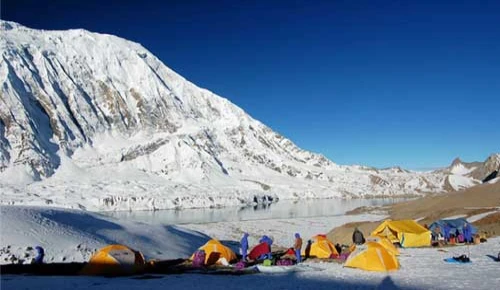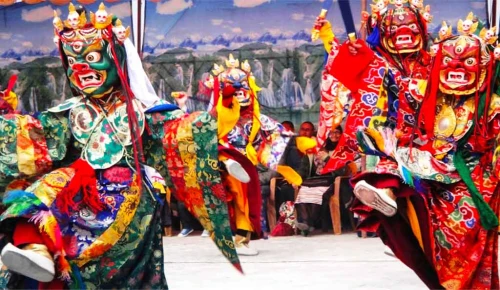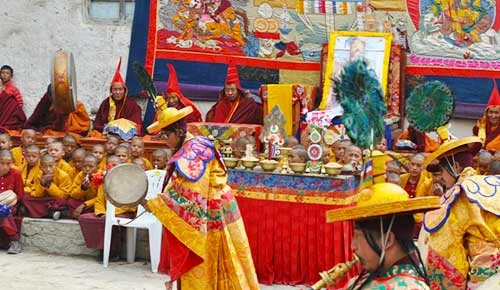Elevated Beauty:The List of Mountains of the Everest Base Camp
"How many mountains can we see while trekking to the Everest Base Camp in Nepal?" is the question that most people ask when discussing the Everest base camp. In this blog post, "The Majestic Mountains of the Everest Base Camp Trek," we talked about the mountains viewed on the trek to Everest base camp.
Everest Base Camp is a popular destination for trekkers and mountaineers from all over the world. Located at an altitude of 5,364 meters (17,598 feet), it provides stunning views of Mount Everest, the highest peak in the world, as well as other towering peaks such as Lhotse, Nuptse, and Ama Dablam.
So, We follow the traditional 14-day Everest Base Camp Trek itinerary to make things easier and best. It is the most well-known route and provides more views of the mountains during the Everest Base Camp Trek 2023 in Nepal.
Table of Contents
14 days EBC Itinerary
Here is a short itinerary of 14-day Everest Base Camp Trek:
- Arrival in Kathmandu
- Flight to Lukla and Trek to Phakding
- Phakding to Namche Bazaar
- First Acclimatization at Namche Bazaar
- Namche to Phortse (Phorche)
- Phortse to Dingboche
- Second Acclimatization day at Dingboche
- Dingboche to Lobuche
- Trek From Gorakshep to Everest base camp and back to Gorakshep
- Gorak Shep to Pheriche via Kala Patthar
- Pheriche to Namche
- Namche to Lukla
- Lukla to Kathmandu
- Departure Day
You have to be lucky with the weather and climatic conditions to have a chance to see all of the Everest Base Camp Mountains in Nepal. We strongly advise booking your Everest Base Camp Trek during the best months, March to May (Spring Season in Nepal) and September to December (Autumn Season).
List of The Majestic Mountains of the Everest Base Camp

According to their height, we've listed the mountains that can be observed while trekking to Everest Base Camp.
Mount Everest
Mount Everest is the tallest mountain in the world, rising 8,848.86 meters (29,031.7 feet) above sea level in the Mahalangur Himal sub-range of the Himalayas. At its summit point, the boundary between China and Nepal stretches.
Lhotse
Lhotse is the fourth-highest mountain in the world at 8,516 meters (27,940 feet) after Mount Everest, K2, and Kangchenjunga. The main summit is located along the boundary between Nepal's Khumbu region and the Tibet Autonomous Region of China
Makalu
Makalu is the fifth-highest peak in the world at 8,481 meters (27,825 ft). It is situated in Nepal, 19 kilometers (12 miles) southeast of Mount Everest, in the Mahalangur Himalayas. Makalu, one of the eight-thousanders and is a remote peak with a four-sided pyramidal shape.
Lhotse Shar
Lhotse Shar is a subordinate mountain of Lhotse at an elevation of 8,383 m (27,503 ft). The typical ascent path to Lhotse Shar via the South Col is located distant from the main summit.
Cho Oyu
Cho Oyu, which rises at 8,188 meters (26,864 feet) above sea level, is the sixth-highest peak in the world. In Tibetan, Cho Oyu is known as the "Turquoise Goddess." The mountain is located 20 kilometers west of Mount Everest and is the Khumbu
Nuptse
Nuptse or Nubtse is located in Nepal's Mahalangur Himal, in the Khumbu region located at an elevation of 7,861 m (25,791 ft)above sea level. It is situated two miles west of Mount Everest. Given that it is the westernmost peak of the Lhotse-Nubtse massif, Nubtse is Tibetan for "west peak."
Nuptse II
Nuptse II is a mountain peak in the Nepalese Himalayas, part of the greater Mount Everest massif. Known for its steep, rocky terrain and challenging climbing routes, Nuptse II is a popular destination for experienced mountaineers.
Pumori
Pumori, also known as Pumo Ri, is a mountain in the Mahalangur region of the Himalayas that is located on the Nepal-China border. West of Mount Everest, Pumori is only eight kilometers away.:
Baruntse
Baruntse is a mountain in the Khumbu region of eastern Nepal that is crowned by four peaks and is bordered on the south by the Hunku Glacier, on the east by the Barun Glacier, and the northwest by the Imja Glacier.
Nirekha Peak
Nepal's Nirekha Peak is part of the same mountain chain as the summits of Lobuche, east of the Cho La Col It is at a height of 6,069 meters (19,911 ft) from the sea level.
Ama Dablam
Ama Dablam Ama Dablam refers to "Mother's necklace," with the long ridges on either side resembling a mother's arms shielding her child (ama) and the hanging glacier being the Dablam, the traditional double-pendant holding images of the gods worn by Sherpa women.
Kangtega
Kangtega is a major peak in the Himalayas in Nepal which is also known as The Snow Saddle at an elevation of 6,782 meters (22,251 ft).
Thamserku
Thamserku is a peak located in the eastern Nepalese Himalayas at a height of 6,608 meters (21,680 feet) above sea level. A ridge running eastward to Kangtega connects the two mountains.
Tawoche
Mount Taboche, with an elevation of 6,495 meters (21,309 ft), is located in the Khumbu area of the Nepalese Himalayas. A lengthy ridge connects Taboche and Cholatse. Taboche is located above the villages of Pheriche and Dingboche and just over the Imja River from Ama Dablam.
Mera Peak
Mera Peak is a mountain located in Nepal's Sagarmatha Zone, Sankhuwasabha, in the Mahalangur sector and Barun sub-part of the Himalayas. It is a trekking peak because it stands at 6,476 meters (21,247 feet) in elevation.
Cholatse
Cholatse is a peak in the Khumbu region of the Nepalese Himalaya with an elevation of 6,440 m (21,130 ft). A lengthy ridge connects Cholatse to Taboche (6,501m).
Arakam Tse
Arakam Tse is a mountain in the Himalaya of Nepal at an elevation of 6,372 meters (20,906ft) above sea level.
Island Peak or Imja Tse
Imja Tse often referred to as Island Peak, is a mountain in the Sagarmatha National Park of the Himalayas in eastern Nepal. It rises at a height of 6,160 meters (20,210 feet) from sea level.
Pheriche Peak
Pheriche Peak is a mountain in the Himalayas of Nepal. It has an elevation of 6,814 meters (22,349 feet) and is located in the Khumbu region, which is home to Mount Everest.
Kyajo Ri
Mountain Kyajo Ri (also known as Kyozo Ri) is located in the Khumbu region of northeastern Nepal, in the western Mahalangur Himal. The mountain, which rises to a height of 6,186 meters, is the highest point of a mountain range that connects the river valleys of Bhotekoshi and Dudhkoshi in the west and east, respectively.
Lobuche Peak
Lobuche Peak is a challenging mountain located in the Himalayas of Nepal, reaching an elevation of 6,119 meters. The peak offers breathtaking views of the surrounding mountain ranges, including Mount Everest and Nuptse.
Phari Lapcha
Phari Lapcha Peak is a stunning mountain located in the Himalayan range of Nepal. It stands at an elevation of 6,059 meters
Kwangde
Kwangde is a mountain located in the Himalayas of Nepal at an elevation of 6,011 m, known for its challenging climb and stunning views of the surrounding peaks.
Khumbila
Khumbila is a sacred mountain in the Himalayas that is considered the guardian deity of the Khumbu region in Nepal, at a height of 5,765 meters.
NangkarTshang
NangkarTshang is a popular peak and amazing viewpoint in the Khumbu region at an elevation of 5,083 meters(16,676ft) from sea level.
Cho La Peak
Cho La Peak is a popular peak trekking destination in the Himalayas, located in the Khumbu region of Nepal which roses at an elevation of 5,420 meters.
Gokyo Ri
Gokyo Ri Gokyo Ri mountains are a stunning range located in the Khumbu region of Nepal, known for their beautiful glaciers and panoramic views of Mount Everest rising at an altitude of 5,357 meters.
Best Season for Majestic Mountains views of the Everest Base Camp
EBC is located at an extremely high elevation (17,600 feet/5380 meters), and the overland journey to reach there is likewise exceedingly high. This implies that even though the Everest region is never truly "warm," there are still seasonal changes in temperature, precipitation, and snowfall.
Autumn and Spring
March, April, May, October, and November are the most popular months for hiking in the Everest region because they are the months with the best weather. The spring and the fall often include mild temperatures, sunny skies, little to no rain, and a reduced likelihood of unfavorable snowfall which is the best thing for the stunning views of various mountains. The trails are busiest during these months as well, but if you're looking for the ideal weather, you might be willing to make that trade-off.
Winter
Although the winter months of December, January, and February are undoubtedly the off-season, they are not necessarily a "poor" time to go to EBC. You would need to be well-prepared for freezing conditions because temperatures can get very low. However, the skies are frequently very clear in the winter, providing stunning mountain views. Also, you won't have to compete for space with other hikers along the way.
Monsoon
It is not recommended to visit EBC during the rainy season (June to early September). The views of the mountains can be obstructed by rain clouds in addition to the wet weather, which can cause mudslides on routes and landslides. But it's also warmer during this time, and it doesn't rain all day every day. However, if you're well-prepared for the rain and don't mind getting a little wet along the way, trekking in the monsoon can be OK because the higher you go in altitude, the less chance of rain falling.
Alternate routes during High Season Crowds
Nepal's peak seasons for Everest trekking and Everest short treks are in the spring and autumn and as the EBC trek is the most well-known in Nepal, the paths might get crowded during these times. There is no chance that you will have the main trails to yourself, and it can be difficult to get the lodging of your choice. Trekking with a guide is usually a good option, but it's especially better during the busiest time of year because they can arrange for lodging that could be challenging if you were solo trekking or traveling alone.
During the busy season, flights to Lukla also tend to sell out very early, so make your reservations as soon as you can.
There won't be as many people around during the winter or monsoon. Although you might not have as much trouble finding a bed at a teahouse as you might in peak season, many businesses close during the off-season.
The traditional EBC route is perhaps the most well-known, but there are numerous additional treks in the area that, even during the busiest months, do not really attract many tourists. Some of the trekkers take a different route to the EBC, while others skip it but still both routes provide trekkers a breathtaking view of the mountains and their surrounding peaks.
Here is the alternative route to Everest base camp which also provides a stunning view of mountains during the ascend.
Jiri to Everest Base Camp
Jiri to Everest Base Camp, commonly known as the "Classic Everest Trek," is a fantastic trek for anyone with plenty of time since it allows hikers to adjust to the altitude well before climbing to Kalapatthar, which is the highest point of the trek at approximately 5,500 meters. Throughout the trek, this trek provides a breathtaking view of several mountains.
Everest Three Passes Trek
The best high pass trek for experienced trekkers who dare to take on the massive Himalayas of the Everest region is the Everest Three Passes Trek. Renjo La, Gokyo valley with a lake, Cho La pass, and Kongma La are included in the Everest Three (3) high passes trek. You will be absolutely mesmerized by the panoramic view of the famous Himalayas and the exotic Gokyo Valley throughout the year, but only for a set amount of time.
Gokyo Valley with EBC
Gokyo Valley Trek with EBC is an enthralling experience for any trekker. It provides a magnificent view of the Gokyo Lakes, gleaming glaciers, and majestic Himalayan peaks. The Valley also offers trekkers access to Everest Base Camp and Gokyo town, which is located near Gokyo Ri.
Gokyo valley trek
The Gokyo lake trek in the Everest region is thrilling and exhilarating, and trekking in the area is breathtaking. Several mountains, including Mount Everest, Mount Lhotse, Mount Makalu, Mount Cho Oyu, Mount Nuptse, Mount Pumori, Mount Ama Dablam, Mount Kantega, and Mount Kwangde, can be seen when trekking to Gokyo Valley.
If trekking isn't on your agenda then a helicopter tour to EBC would be also best in clear, consistent weather. To see the spectacular view of the mountains, you don't need to hike for a full day. Simply book a helicopter ride to Everest base camp to take in the breathtaking aerial view of Mount Everest and other magnificent peaks.
Conclusion
In conclusion, whether you go for a trekking or helicopter tour, both ways are the best option to witness the beautiful view of the mountains in the Everest region. NTA offers various packages to Everest base camp that offers stunning mountain views. You can book your trip according to your desire.





